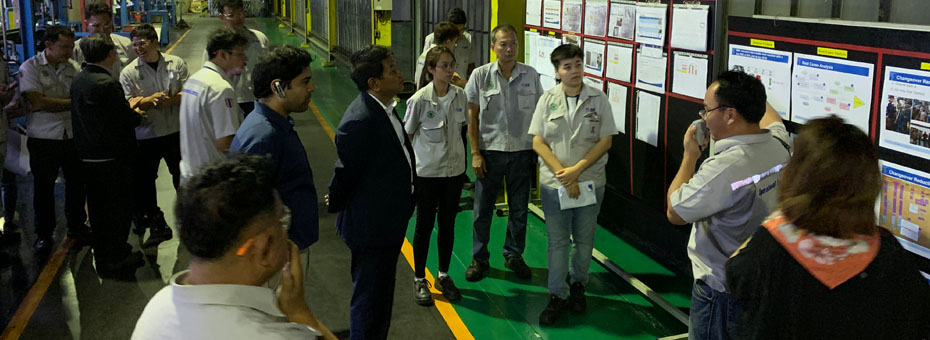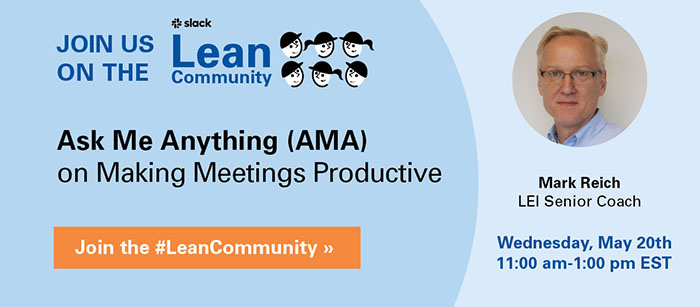Like many of you, my life changed drastically a little more than a month ago. After flying nearly 40,000 miles during the months of January and February to places like Budapest, Bangkok, and yes, New York City, suddenly, my travel stopped.
After being accustomed to meeting at the gemba somewhere in the world every week, the last five weeks have been filled with an endless chain of virtual meetings. It sometimes seems almost rude to excuse myself in the middle of this series of meetings to, god forbid, go to the bathroom. And since my bathroom sits near my home office, I’ve got to be careful when I get back, that I don’t go off mute before the toilet completes its flushing cycle. Things that might have been discussed in a client facility, casually at the office “watercooler,” or at a colleague’s desk now have to be handled through virtual communication, which feels isolating.
But in a recent conversation, I heard great advice from Peter Davoren, the CEO of Turner Construction (a Co-Learning Partner of LEI). He advised his leadership team to “combat isolation with productivity.” What a great idea – but how can we be more productive when we are always in virtual meetings?
For a potential answer, I reached back to my experience at Toyota, where, as a corporate strategist and product planner, I participated in a lot of meetings. At Toyota, every meeting had a purpose and plan. We used meetings to build consensus and alignment as well as reinforce a culture of teamwork. We also viewed meetings like any other product we deliver, so we were pretty effective at running meetings. And I learned two critical elements of hosting productive meetings. First, we must know how to engage people, which means knowing what type of communication is required before considering whether a meeting is needed or what kind of meeting is needed. Second, if a meeting is necessary, then we must work to make the meeting more productive with PDCA.
In this post, I’ll address the first element, and in another post tomorrow, I’ll discuss the second.
Ho-Ren-So
Toyota referred to its communication framework as “Ho-Ren-So,” which directly translated into English, is the word for spinach — which is not how Toyota used the term. Nevertheless, it always makes me think of Popeye and how spinach gave him superpower. In this case, not muscle power, but rather the power of communication! Following the Ho-Ren-So framework helps determine which type of communication is needed and, in turn, how to engage people. Taking this first step can make all kinds of communication more helpful, supportive, efficient, and developmental.
Toyota used Ho-Ren-So as an acronym. Each of the three syllables derives from the first syllables in three words that represent Toyota’s communication framework:
- Ho, from the first syllable of Hokoku, the Japanese word for “to report-out”
- Ren, from Renraku, the Japanese term for what English speakers would call “to touch base”
- So, from Sodan, the Japanese word for “to ask for consultation”
To a significant extent, Hokoku, Renraku, and Sodan defined fundamental principles of structured communication at Toyota.
Switching the order around a bit, you can see these communication ways as different levels of formality or engagement, as well as time investment.
- Renraku (touch base) is used to merely let people know about an issue that occurred that might impact work.
- Sodan (ask for consultation) is useful when one needs support or input before moving further, such as from your boss, a colleague, or an outside party, depending on the issue.
- Hokoku (report out) is the most formal as you share your thinking with key stakeholders. The tool we most frequently used in Toyota for this purpose was the A3.
As you can imagine, Renraku or and Sodan are–most frequently used for one-on-one communication (phone, email, text, etc.), while Hokoku is most commonly used for structured meetings, though this is not black and white. A quick HR update is a Renraku example that we might use in the context of a meeting. Similarly, we may want to ask for consultation from more than one person, which also could be done in a meeting. However, generally speaking, Renraku and Sodan favor one-on-one discussion, and Hokoku lends itself to a structured meeting.
Any of these three communication mechanisms can be applied in the context of a meeting. Now, in this new virtual world of meetings I’ve now been plopped into, I find two major problems:
- First, we too frequently use structured meetings to provide Renraku and Sodan, which causes two problems:
a) Issues that should be addressed through a “touch base”: or “request for consultation” require quick input from the right advisor. Bringing them into a forum where everyone on the team provides feedback often creates unnecessary discussion.
b) Waiting until the meeting happens causes lead-time delay. Many Renraku and Sodan issues are often small issues that are roadblocking progress because the Team Member needs help or authority to proceed. In a lean sense, Sodan is like the administrative version of “pulling the andon.” The Team Member needs quick advice from the Team Leader.
- Second, we often come unprepared for meetings because the structure of Hokoku is not in place.This means:
a) The “owner” of the problem doesn’t state the issue clearly, so we just talk on about a problem that exists with no real resolution, or
b) There is no written material for which we can provide input. The inference of Hokoku is that we are reporting out on something, such as in an Obeya where problems are visualized and easily discussed (virtual obeya too!) or a written document. Without this, a meeting tends to devolve into people offering uninformed opinions, which makes it difficult to reach a resolution.
Why do organizations have meetings? I think the basic concept is simple – we want to build alignment, get input to a proposal, or communicate critical information that some people may be aware of but not others. So like Toyota, please first define your framework for communication and clearly define what needs to be a part of your meetings, what does not, and how to make meetings most productive with the right type of communication.
Tomorrow, let’s dig into the details of how we can all effectively execute on the meetings we run.







